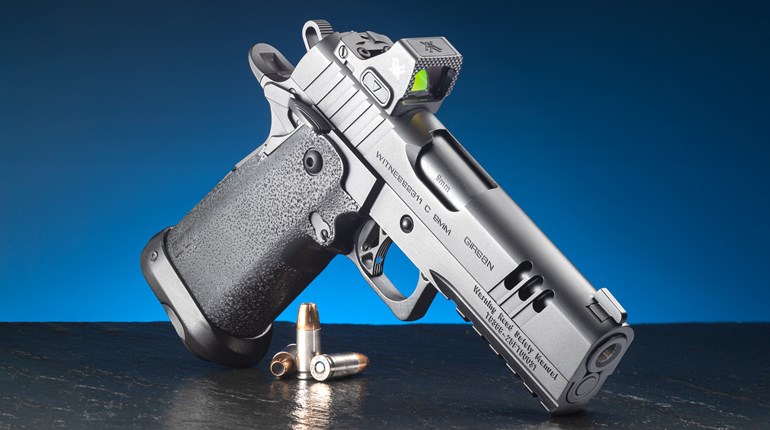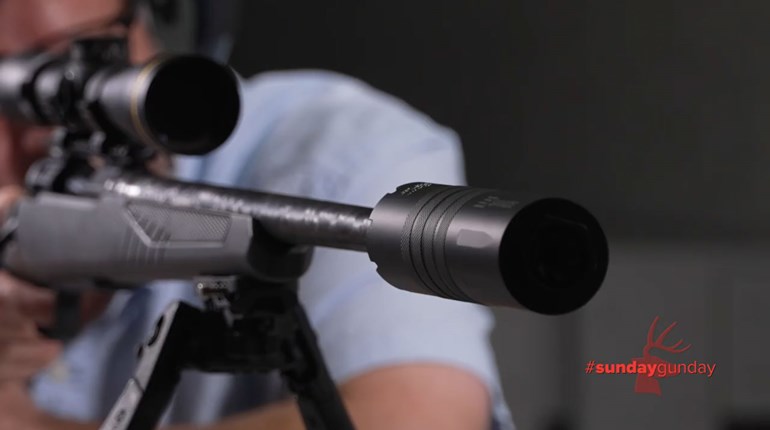
For a long while, Taurus had a pretty decent gig churning out copies of Smith & Wesson revolvers. In the 1970s, the same conglomerate that owned Smith & Wesson purchased a controlling interest in Taurus, so the two companies shared technology and designs. In 1980, Taurus purchased Beretta’s São Paulo, Brazil, operational facility after completion of a contract, which included technical specifications, tooling and the retention of skilled workers. This allowed Taurus to produce PT-92 and PT-99 handguns, quite similar to the Beretta 92s that had formerly been produced at the facility for the Brazilian army. Taurus branched out in the 1990s with designs produced in its Miami, FL, location that had similarities to small Beretta semi-automatics as well.
While Taurus produced its first 1911 in 2005, the following year would see the handgun that would define Taurus for the 2000s: The Judge. A five-shot revolver capable of accepting .410-bore shotshells, the Judge—and its various permutations—was quite the surprise hit. The early 20-teens were filled with Taurus experimenting with various semi-automatic designs, all with various degrees of acceptance. In the later part of the last decade, though, a new focus brought about by new leadership saw a significant change in direction. Taking a “fresh sheet of paper” approach, the PT-111 Millennium G2 morphed into the G2, which spawned the G2C, then the G3/G3C and ultimately resulted in the pistol that is the subject of this article: the GX4.
Bret Vorhees, TaurusUSA president and CEO, described this approach: “So, we started with a fresh sheet of paper, making sure we kept those features and characteristics of the G2C that consumers appreciated while applying technical and design innovations that would take the Taurus polymer striker-fired platform to the class-leading position it enjoys today. So remarkable has been the success of the G3, along with the G3 TORO and the G3C that quickly followed, that we have now translated the best of those models, along with even more technological innovations, to bring to market the new GX4 micro-compact.”

The GX4 is neither a copy of an existing design nor an esoteric conversation piece like many of Taurus’ previous offerings, some more successful (The Judge) than others (The Curve). The GX4, though, is its own pistol; while it shares dimensions and function with a host of other handguns, it is its own design. It is remarkable in that it is unremarkable—strip logos from the GX4 and its closest competitors and folks would be hard-pressed to tell them apart. Interestingly, Taurus has evolved to the point where it is comfortable with its own design and engineering teams. We’re seeing firearm-company evolution in action; with this latest line of handguns, Taurus appears to be, at long last, coming into its own.
Along with this, of course, is a commitment to quality. While Taurus firearms have had a lifetime repair policy since the presidency of Ronald Reagan, it seems that lately, it is needed less and less. Returns have decreased 36 percent, while turnaround times for repair have shrunk—from multiple weeks to mere days—as well. Taurus is making more reliable firearms, and the smaller number that need attention are addressed quickly. The company knows it still has work to do, and is making great strides in reliability and customer service.
Vorhees explained the reasons for the change in emphasis: “In the last few years, though, our approach has changed quite significantly. It’s no longer about what we can make, but what our consumers and dedicated fans want us to make. The consumer takes the lead by telling us how Taurus firearms can better support their lifestyle, their passions and their needs. From that, we apply our decades of experience and the latest in manufacturing and material technology to deliver on those requests.”

But, back to the GX4. This pistol is a lovely little Rorschach test among the general gun-owning public. “It’s a clone of the SIG Sauer P365!” sneer some, while others exclaim, “It’s just a different-looking Springfield Armory Hellcat!” This is a phenomenon we’ve noted in the past with other, novel handguns. When you’re talking about a near-pocket-size handgun with a two-finger(ish) grip and a thin double-stack magazine, there’s not a lot of visible variation. Heck, there’s not a lot of space on the gun to have variation. With most competitors having 10- or 11-round magazine capacity, barrels less than 3.5 inches and profiles too thin for standard rails, if Taurus wanted its micro-9 mm double-stack to succeed, it had to follow this same format.
What’s especially interesting in the case of the GX4 is how quickly Taurus spooled up its R&D game to produce it. The company launched the G3, itself an outgrowth of the Millennium G2, in 2019, followed up with a compact model in 2020 and, just a little earlier in 2021, updated both G3 variants with optics-compatible versions in the T.O.R.O. line. Just a few short months later, the GX4 was released. That’s an absolute ton of new development in a miniscule amount of time—and, let’s not forget, much of it happening in the midst of a global pandemic that brought about shutdowns, restrictions on personnel capacity and raw-material shortages. Launching the GX4 this quickly in a vacuum would be impressive; given everything else going on in the world it’s fairly astounding.
It’s not just enough that the GX4 came to be, though. It’s an excellent little pistol in its own right. It checks all the right boxes—capacity, trigger, sights—while keeping the value for which Taurus is known. MSRP on the GX4 is roughly $150 less than the next-closest competitor (of which there are many), and the only thing the GX4 lacks (for now) is the ability to add a red-dot sight. Don’t let the price fool you—Taurus’ little pistol is every bit as capable as the rest of the field. Finish, too, is quite nice, with beveled edges on the slide to reduce sharp corners, front and rear cocking serrations and full texturing on the grip that allows purchase without being abrasive.
Control-wise, the GX4 is minimalist. There’s a reversible magazine release, a right-hand-only slide stop lever and a takedown pin. That’s it. As expected, the trigger has a bladed safety to guard against inadvertent firing should it be dropped. The trigger itself is flat-faced and breaks when perpendicular. The safety has a slight texture to ensure positive finger placement, and presents a uniform, flat surface when the trigger is pulled. Take-up and reset are minimal—think of the pull as a three-step process: There’s a miniscule distance needed to pull the safety into the trigger, perhaps a quarter of an inch of take-up and then the actual break. It’s a tad on the heavy side, but not excessively so, especially in light of the absence of other manual safety devices.
Unlike the G2/G3 models, there is no “second-strike” capability on the GX4. Should a round not fire for whatever reason, a traditional immediate-action drill (the quintessential tap-rack-assess) will need to be performed. Given that this is (or should be) standard operating procedure for an unknown failure in a semi-automatic, striker-fired pistol, the lack of second-strike capability shouldn’t be a drawback.

Up top, the sights on the GX4 sure look like Taurus is listening to shooters. Rather than a traditional three-white-dot arrangement, the rear sight is a serrated-face, plain black setup. This allows the white-dot front sight to really draw your attention to it. “Front sight, press,” right? Should night sights or other arrangements be desired, the rear assembly is seated in a dovetail and the front blade uses a screw-attachment system analogous to a certain Austrian pistol (but not the same screw, mind you). Also on the slide is a barrel-hood half-moon cutout that serves as a loaded-chamber indicator.
On the polymer frame, the same texturing that surrounds the grip is present in two areas above the trigger guard (left and right side). These are what Taurus deems “indexing pads” as a reference to where your trigger finger should rest when not actually firing the GX4, and present a tactile reminder to keep the trigger finger not just off the trigger, but out of the trigger guard entirely if not ready to fire. Around the back of the frame is an interchangeable backstrap to better fit the GX4 to the shooter’s hand, with large and small backstraps swapping out with the removal of a roll pin.
 Since we’re on the subject of hands, it is worth noting that medium or larger hands will find the flush-fitting magazine too small to support the pinkie finger. While not included with the GX4, a 13-round magazine is available that has a bumper section to remedy this. Also note that with the flush-fit magazine, hands on the larger side may impinge the magazine dropping free—which is why Taurus engineered a lip on the bottom of the magazine. When reloading, be careful when inserting a fresh magazine. There will be pinching and (if you’re like me) cuss words. I find a slight realignment of the strong-hand grip will alleviate both problems. Simply rotate the outside of your strong hand slightly away from the grip to both allow the spent magazine to drop free (or be stripped by the support hand) as well as to avoid any pinching with the newly inserted magazine.
Since we’re on the subject of hands, it is worth noting that medium or larger hands will find the flush-fitting magazine too small to support the pinkie finger. While not included with the GX4, a 13-round magazine is available that has a bumper section to remedy this. Also note that with the flush-fit magazine, hands on the larger side may impinge the magazine dropping free—which is why Taurus engineered a lip on the bottom of the magazine. When reloading, be careful when inserting a fresh magazine. There will be pinching and (if you’re like me) cuss words. I find a slight realignment of the strong-hand grip will alleviate both problems. Simply rotate the outside of your strong hand slightly away from the grip to both allow the spent magazine to drop free (or be stripped by the support hand) as well as to avoid any pinching with the newly inserted magazine.
Field-stripping the GX4 is quite easy, but may be somewhat controversial in that it does require a trigger press. The internet is ablaze with comments on this practice, with some folks thinking this is more dangerous than handing a baby a switchblade, while others argue that following safe gun-handling procedures will minimize unintended loud noises. Be sure the GX4 is unloaded—drop the magazine, lock the slide back and visually and tactilely ensure that the chamber is empty. Check again, just to be sure. Once you are 100-percent certain the gun is unloaded, release the slide and point in a safe direction. Pull the trigger. Now, all that’s needed to do is to use a small flathead screwdriver to rotate the takedown pin 90 degrees. Be careful to have the slide parallel to the ground, and ideally over a towel or other soft surface. I’m not just saying this because I bounced the slide off my kitchen counter the first time I took the GX4 down.
On the range, the GX4 performed exactly as expected. I didn’t consider the recoil to be terribly snappy, all things considered. However, I also have a penchant for ridiculously heavy-recoiling firearms, so I may not be the best judge of what may or may not be snappy. But, I digress. In any case, it was quite controllable over a wide variety of ammunition. While the current state of ammunition supplies and potential (lack of) replenishment meant I wasn’t able to put through as many rounds as I would have liked, approximately 250 rounds went through this particular GX4 without a single incident. It just plain worked. I’ve also shot a couple of different GX4 pistols for our “I Carry” video series with no malfunctions. As a last piece of data, I attended a writer’s event that saw two GX4s shot by more than a dozen different attendees, again without any failures.
In our testing, we opted for a wide range of projectiles. From the super light 50-grain Pilgrim Ammunition solid-copper hollowpoint screaming out of the 3-inch barrel at 1,900 fps to heavy Federal Hydra-Shoks lumbering along at less than 900 fps, the GX4 digested everything we put into it. Of course, standard FMJ 115- and 124-grain projectiles, including +P, were tested as well, again with no malfunctions. The Taurus GX4 proved to be a completely drama-free pistol, and that’s a good thing.
So, what’s the verdict on the GX4? Definitely try one for yourself, but if you’re in the market for one of these new-fangled, double-stack micro-9 mm pistols, don’t pass it up. Taurus’ new GX4 is not just good, it achieves the highest accolade I can bestow on a gun: It’s boring. It does what you expect it to do without fail. There are no surprises, oddities or “buts” (as in, “it’s a good pistol, but …”) about it. If there are any knocks on the GX4, they’re minimal—I was going to point to the lack of an optics cut as a slight ding, however, at the writer’s event I had a chance to chat with Jorge Spät, one of the product managers on the GX4 project, who mentioned that “Taurus fans will soon be getting their hands on the newest iteration of the GX4 micro-9 mm compact—the GX4 TORO.” Spät also teased: “We’ve also recently announced our new Taurus Black Label brand, which is our “custom shop” approach that takes our most advanced pistols to the next performance level. We have several intriguing projects that will be emerging from the Taurus Black Label shop in the coming months.”
The currently scant aftermarket should remedy itself rather quickly. Magazines, holsters and other gear will become available, and more than likely, by the time you read this the folks at Taurus will have released the GX4 TORO for those who prefer red-dot sights on their defensive handguns. This bull is ready to run.







































